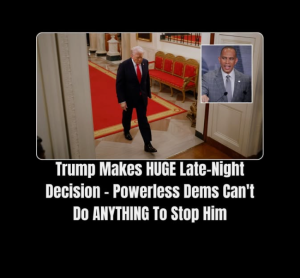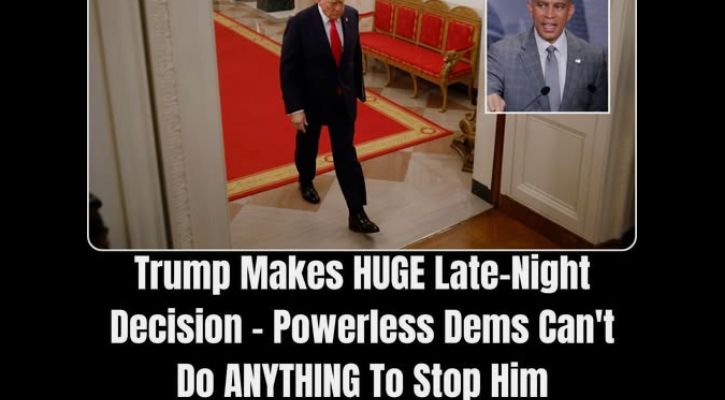
President Donald Trump recently made headlines by releasing dramatic video footage that he claimed shows the moment U.S. forces destroyed a “drug-carrying submarine” in the Caribbean Sea. The footage, presented as part of the administration’s growing campaign against international narcotics smuggling, depicts a precision strike on what officials described as a narco-submarine loaded with fentanyl and other illegal drugs bound for American shores. Trump announced that the attack prevented a “massive wave of death” from entering the United States and declared the operation a major victory in what he now calls “America’s War on the Narco-Terrorists.”
According to the president’s statement, the vessel was intercepted by U.S. forces in the Caribbean during a nighttime mission. The intelligence that led to the strike reportedly came from a combination of satellite tracking, naval reconnaissance, and signals intercepts. The military classified the vessel as a semi-submersible craft — a type often used by Latin American cartels to move tons of drugs under the radar of radar systems and maritime patrols. Trump said four people were aboard. Two were killed in the explosion, and two survivors — citizens of Ecuador and Colombia — were captured and are being sent back to their home countries for prosecution. The president emphasized that if the submarine had made it to U.S. waters, the drugs on board could have killed up to 25,000 Americans. He praised U.S. military intelligence and called the operation “a model of decisive leadership.”
The footage, which was released through both the White House and Trump’s social media platform, shows aerial thermal images of a fast-moving craft just below the surface of the water. Moments later, a missile strike hits the vessel, producing a fiery plume that quickly engulfs the area. The U.S. military confirmed the authenticity of the video but has not released details about the weapon used. Defense officials say the strike took place in international waters under the authority of the president’s standing directive to neutralize maritime drug threats. While the footage has captivated the public, it has also sparked widespread debate about the legality, morality, and broader implications of using military force against suspected smugglers.
Independent reports from major outlets confirm several key details. U.S. officials have verified that the strike occurred in the Caribbean and that two survivors are in custody. Ecuadorian and Colombian authorities have acknowledged that their nationals were aboard but have yet to find any clear evidence connecting them to criminal networks. Ecuador’s foreign ministry said it has not received proof that its citizen was part of a narcotics operation, raising questions about the identification process and the rules of engagement that led to the strike. Human rights observers have called for transparency regarding how targets are identified and whether lethal force was the only available option.
What remains unclear is the exact nature of the vessel and the amount of contraband it carried. Although the Trump administration repeatedly refers to it as a “drug submarine,” independent experts suggest it may have been a narco-submersible — a low-profile vessel designed to evade detection but not a true submarine. No verified images of recovered debris or seized drugs have been released to the public. Critics argue that without physical evidence, claims about the quantity and type of narcotics onboard remain unproven. Trump’s statement that “25,000 Americans would have died” if the vessel had not been destroyed is viewed by many as rhetorical exaggeration intended to highlight the fentanyl crisis rather than a literal statistical estimate.
This operation marks the latest in a series of military strikes the Trump administration has carried out since early September against suspected drug-trafficking vessels in the Caribbean and along the Venezuelan coast. These actions have killed at least two dozen people and destroyed several boats believed to belong to drug cartels. Trump has framed these operations as part of a “non-international armed conflict” against narcoterrorist organizations. By using that designation, the administration treats cartels not as criminals but as hostile combatants, thus applying the laws of war rather than traditional law enforcement rules. This distinction is controversial because it stretches the legal definition of armed conflict into an area historically managed by police and coast guard operations.
International law experts are divided. Some argue that the U.S. has the right to defend itself from drug-related threats under self-defense principles, while others say the strikes violate international maritime law. They point out that drug trafficking, however serious, does not constitute an armed attack and therefore does not justify military force without congressional authorization or United Nations approval. Critics fear that the normalization of such strikes could set a dangerous precedent, blurring the line between policing and warfare. The War Powers Resolution, which limits a president’s ability to conduct hostilities without congressional consent, has not been formally invoked. This leaves open questions about oversight, accountability, and the chain of command in these operations.
Regionally, the strike has generated mixed reactions. Colombia expressed “deep concern” about the loss of its citizen and called for clarification regarding the evidence behind the U.S. action. Ecuador’s government demanded proof that its citizen was involved in drug trafficking, stressing that “cooperation against narcotics must follow international law.” Venezuela, already hostile toward Washington, accused the United States of violating regional sovereignty and using anti-drug operations as a pretext for militarization. Even among U.S. allies, there is quiet unease about the growing use of drones and missiles in interdiction missions that traditionally rely on boarding and seizure rather than lethal engagement.
Domestically, Trump’s supporters have hailed the strike as a demonstration of strength and decisive leadership. They argue that the drug crisis has killed more Americans than any recent war and that unconventional measures are necessary to dismantle the networks responsible for flooding U.S. streets with fentanyl and cocaine. The footage, released only days before a series of major campaign events, has been widely shared on social media, accompanied by messages emphasizing the president’s commitment to protecting American lives. For his base, the operation reinforces the image of a leader willing to act boldly where others hesitated.
However, civil liberties groups, maritime lawyers, and some members of Congress warn that the administration’s approach undermines due process and risks entangling the U.S. in undeclared conflicts. They question how targets are verified, whether the intelligence used meets evidentiary standards, and what happens to survivors who are captured in such operations. The lack of transparency about how decisions are made has led to growing calls for oversight hearings. Some lawmakers are demanding that the administration provide classified briefings to confirm that the vessel indeed posed an imminent threat to American lives.
Beyond legality and politics, the broader question is whether these operations will meaningfully reduce the drug supply reaching the United States. Analysts note that for every vessel destroyed, cartels quickly replace their losses, adapting their routes and technology. The use of military strikes may slow trafficking temporarily but is unlikely to dismantle the underlying networks that rely on corruption, economic desperation, and global demand. Critics argue that investing in interdiction without addressing demand or production only treats the symptom, not the disease. Still, the spectacle of powerful military hardware destroying a narco-submarine delivers a potent image of deterrence, at least in the short term.
Strategically, the U.S. appears to be signaling that it will no longer tolerate the blurred lines between organized crime and national security threats. The Trump administration’s stance represents a significant shift from previous policies that focused on multinational cooperation, law enforcement, and extradition treaties. Whether this new doctrine of preemptive military action against non-state narcotics actors becomes a lasting feature of U.S. policy will depend on how the courts, Congress, and public opinion respond in the coming months.
For now, the released footage and Trump’s declaration have reshaped the conversation around the global drug war. The imagery of a missile obliterating a suspected smuggling vessel resonates with a nation weary of fentanyl deaths and cross-border crime. Yet beneath the spectacle lies a complex debate over power, legality, and moral responsibility. The destruction of the “drug-carrying submarine” may be celebrated as a tactical success, but it also raises a deeper question — whether victory in the war on drugs can truly be won through the tools of warfare alone.

